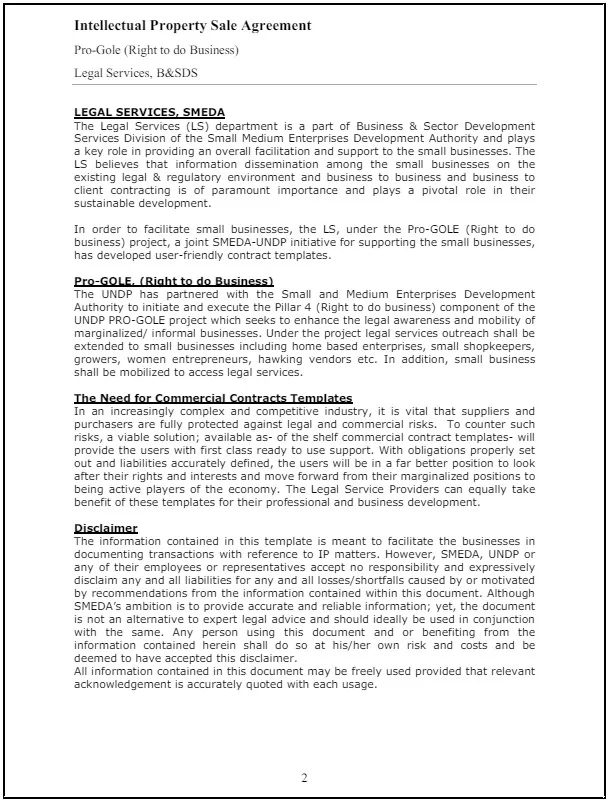In the digital age, intellectual property (IP) has become a cornerstone of business strategy. Whether you’re an artist, inventor, or entrepreneur, protecting and monetizing your creations is crucial. One effective way to manage your IP is through a sale agreement. This blog post will explore everything you need to know about intellectual property sale agreement templates, including their importance, key components, and how to create one.
What is an Intellectual Property Sale Agreement?
An intellectual property sale agreement is a legal contract that facilitates the transfer of IP rights from one party (the seller) to another (the buyer). This can include patents, trademarks, copyrights, trade secrets, and more. The agreement outlines the terms and conditions of the sale, including the scope of the rights transferred, payment details, warranties, and liabilities.
Importance of Intellectual Property Sale Agreements
- Legal Protection: A well-drafted agreement protects both parties by clearly defining the rights and responsibilities related to the IP transfer.
- Transfer of Ownership: It ensures a clear transfer of ownership from the seller to the buyer, avoiding future disputes.
- Monetization: It allows creators to monetize their creations by selling or licensing their IP rights to interested parties.
Key Components of an Intellectual Property Sale Agreement
- Parties Involved: Identify the parties involved in the transaction, including their contact information and legal status.
- Description of IP: Define the intellectual property being transferred, including specifics like registration numbers, if applicable.
- Transfer of Rights: Detail the scope of the rights being transferred, whether exclusive or non-exclusive and the territories covered.
- Consideration: Outline the payment terms, including the total amount, payment schedule, and method of payment.
- Warranties and Representations: Include any warranties provided by the seller regarding the ownership and validity of the IP rights.
- Indemnification: Specify the responsibilities of each party in case of any legal claims related to the IP.
- Confidentiality: Include provisions to maintain the confidentiality of any proprietary information exchanged during the transaction.
- Governing Law and Jurisdiction: Specify the laws that govern the agreement and the jurisdiction in which disputes will be resolved.
Top Free Intellectual Property Sale Agreement Templates
Here is my selection of the top 5 Free Intellectual Property Sale Agreement Templates to assist you quickly.
***** Template Rated 1st *****
Source: bestofficefiles.com
**** Template Rated 2nd ****

Source: msofficedocs.com
**** Template Rated 3rd ****

Source: sec.gov
**** Template Rated 4th ****

Source: smeda.org
**** Template Rated 5th ****
Source: pandadoc.com
How to Create an Intellectual Property Sale Agreement
Creating a robust intellectual property sale agreement involves several steps:
- Research and Preparation: Understand the types of IP involved and their legal implications.
- Template Selection: Choose a suitable template or seek legal advice to draft a custom agreement.
- Drafting the Agreement: Customize the template to include specific details about the IP, parties, and terms of the sale.
- Review and Negotiation: Review the agreement with legal counsel and negotiate terms with the other party.
- Execution: Sign the agreement with all parties involved and retain copies for your records.
Sample Intellectual Property Sale Agreement Template
Below is a simplified template for an IP sale agreement:
[Title]: Intellectual Property Sale Agreement
Parties:
- Seller: [Name], [Address], [Contact Information]
- Buyer: [Name], [Address], [Contact Information]
Background:
- [Brief description of the intellectual property being transferred]
Agreement:
- Transfer of Intellectual Property:
- The Seller agrees to transfer all rights, title, and interest in the following intellectual property to the Buyer: [List of IP, including any registration numbers].
- Consideration:
- In consideration of the transfer, the Buyer agrees to pay the Seller the sum of $[Amount] according to the following schedule: [Payment terms].
- Warranties:
- The Seller warrants that they are the rightful owner of the intellectual property and have the authority to transfer the rights specified in this agreement.
- Governing Law:
- This agreement shall be governed by and construed by the laws of [State/Country].
- Miscellaneous:
- This agreement constitutes the entire understanding between the parties and supersedes all prior agreements.
Signatures:
Seller: ___________________ Date: __________
Buyer: ___________________ Date: __________
In conclusion, intellectual property sale agreements are essential tools for protecting and monetizing intellectual property. By clearly outlining the rights and responsibilities of each party, these agreements mitigate risks and ensure a smooth transfer of ownership. Whether you’re an artist, inventor, or business owner, understanding and using these agreements effectively can safeguard your creations and support your business goals.
For further guidance, it’s advisable to consult with a legal professional who can tailor an agreement to your specific needs and ensure compliance with relevant laws and regulations.
Remember, protecting your intellectual property is not just about securing your creations but also about safeguarding your business’s future.

Jim Karter is a seasoned blogger with a profound interest in the intricacies of office document processes. With years of experience in the field, Jim has dedicated his career to helping individuals and businesses streamline their daily tasks through the use of efficient and practical templates. His passion for organization and productivity shines through in every piece of content he creates.


